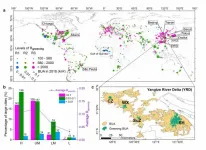(Press-News.org) The world has experienced dramatic urbanization in recent decades. According to the latest report from the United Nations (UN), the global population in 2018 was 7.6 billion and the urban population was 4.2 billion. By 2050, the global population is expected to soar to 9.7 billion, with 68% of the population living in urban areas. (Note 1)
In the first-ever study on the characteristics of urbanization in large cities around the world, researchers at the Department of Civil Engineering of the University of Hong Kong (HKU) analyzed cities' urban built-up areas (BUAs) expansion, population growth and greening BUA changes, and revealed a hugely uneven pace of urbanization in those cities in the last two decades. They warn against major challenges posed to sustainable development if the urban problems are not dealt with in a timely manner. The findings have been published in Nature Communication.
The study, conducted by Professor CHEN Ji at the Civil Engineering Department of the Faculty of Engineering, HKU, in collaboration with the Shenzhen Institute of Advanced Technology, Chinese Academy of Sciences, and National Supercomputing Center in Shenzhen, analysed the development of 841 large cities throughout the world with BUAs of over 100 km2 (Note 2) based on MODIS satellite data from 2001 to 2018 obtained under the International Geosphere-Biosphere Programme.
Breakdown of the 841 large cities by country income-levels
353 cities (42.0%) from high-income countries (e.g. New York in US, Tokyo in Japan)
340 cities (40.4%) from upper-middle-income countries (e.g. Pearl River Delta (PRD) and Beijing in China, Sao Paulo in Brazil)
127 cities (15.1%) from lower-middle-income countries (e.g. New Delhi in India, Cairo in Egypt, Lagos in Nigeria)
21 cities (2.5%) from low-income countries (e.g. Kathmandu in Nepal, Dar es Salaam in Tanzania)
The findings revealed unevenness between built-up areas expansion (BUAE), which reflects the pace of infrastructure development, and urban population growth among the cities; and a widening gap between rapid urban population growth and slow urban greening, represented by features including new parks, green spaces and green roofs.
Cities in the upper-middle-income countries demonstrated the highest BUA expansion, which was more than three times that of high-income countries. Urban expansion and urban population growth in high-income countries remained the lowest. Cities in the low-income and lower-middle-income countries had the highest urban population growth on average, but were substantially lagging behind in BUA expansion and infrastructure development, resulting in serious urban problems such as slums and crowding.
The findings also revealed rapid urbanization of large cities in China in the last two decades. The country had undergone the biggest urban expansion in the period, between 2001 and 2018, its BUA increase accounted for 47.5% of the total expansion in the world. In 2018, the country has 19% of the total BUA of large cities in the world.
"Due to the rapid economic growth in the study period, China invested a large amount of resources into infrastructure construction for advancing the urban living environment. Its progress in greening has been impressive, benefitting at least 108 million city dwellers, accounting for 32% of the total greening at BUAs in the large cities over the world." Professor Chen said.
Of the 841 cities studied, 325 showed significant greening with more than 10% of greening BUAs. Among them 101 are located in China. The largest greening BUAs are Pearl River Delta (PRD)(Note 3), Tokyo, Yangtze River Delta (YRD, Note 4), Miami, Beijing, Chicago, Seoul, Tianjin, Sao Paulo, and Osaka. In 2018, cities in the highest quarter of greenness range accommodated only 12% of the total city population; about 69% of the total population lived in areas with a lower greenness.
"China will reach carbon emission peak before 2030 and carbon neutrality by 2060, and large cities with a significant greening trend play an important role in neutralizing carbon emission and mitigating the impact of global climate change in urban areas. For the majority of the developing countries, understanding the uneven urbanization in the past decades can provide scientific references for urban management, helping to strike a balance between urbanization, population growth and environmental changes." Professor Chen said.
"Our research provides a low-cost method for monitoring sustainable urban development globally, and the quantitative findings contribute to a better understanding of how to achieve rational urbanization and sustainable development in various cities. The findings also serve as a warning that continuing and rapid urban development without proper and long-term planning can be detrimental and the urgent need is to strengthen urban planning and governance, especially in developing and least developed countries." Professor Chen added.
INFORMATION:
Note 1: United Nations. World Urbanization Prospects: The 2018 Revision online edn (United Nations, 2018).
Note 2: For reference, Hong Kong Island has an area of 78.64 km2
Note 3: Pearl River Delta (PRD) is taken as a 'mega' city in the study comprising a cluster of cities including Guangzhou, Shenzhen, Dongguan, Foshan and Zhongshan
Note 4: Yangtze River Delta includes cities of Shanghai, Suzhou, Wuxi and Changzhou
Article in Nature Communications
"Dramatic uneven urbanization of large cities throughout the world in recent decades" by Liqun Sun, Ji Chen, Qinglan Li & Dian Huang
Link: https://www.nature.com/articles/s41467-020-19158-1
A new advanced computing technique using routine medical scans to enable doctors to take fewer, more accurate tumour biopsies, has been developed by cancer researchers at the University of Cambridge.
This is an important step towards precision tissue sampling for cancer patients to help select the best treatment. In future the technique could even replace clinical biopsies with 'virtual biopsies', sparing patients invasive procedures.
The research published in European Radiology shows that combining computed tomography (CT) scans with ultrasound images creates a visual guide for doctors to ensure they sample the full complexity of ...
In the future, the Antarctic could become a greener place and be colonised by new species. At the same time, some species will likely disappear. 25 researchers recently presented these and many other findings in a major international project, in which they analysed hundreds of articles on the Antarctic published in the past ten years. By doing so, the team have provided an exceptionally comprehensive assessment of the status quo and future of Antarctica and the Southern Ocean that surrounds it.
Never before have researchers arrived at so many new findings on the biological and biochemical processes at work in the Antarctic than in the past ten years. Now 25 experts, led by the Alfred Wegener Institute Helmholtz Centre for Polar and Marine Research (AWI), have analysed and compiled these ...
Smoking is associated with an increased risk of COVID-19 symptoms and smokers are more likely to attend hospital than non-smokers, a study has found.
The study published today in Thorax, by researchers from King's College London, investigates the association between smoking and the severity of the COVID-19.
Researchers analysed data from the ZOE COVID Symptom Study App. Of the participants of the app, 11% were smokers. This is a lower proportion than the overall UK population of 14.7%, however, it reflects the demographics of the self-selected sample of the ZOE COVID Symptom Study.
While more than a third of users reported not feeling physically well during the period of study (24th March and April 2020), current smokers were 14% more likely to develop the classic triad of ...
DALLAS, Jan. 6, 2021 -- Statins, common cholesterol-lowering medications, may protect women's hearts from damage caused during chemotherapy for early-stage breast cancer, according to new research published today in the Journal of the American Heart Association, an open access journal of the American Heart Association.
"Two types of cancer medications, anthracyclines and trastuzumab, are effective treatments for many women with breast cancer, however, the risk of heart muscle damage has limited their use, particularly in women who are at higher risk for heart problems because of their age or other medical issues," said Husam Abdel-Qadir, M.D., Ph.D., lead author of the study, assistant professor of medicine at the University of Toronto's ...
Toronto - New research from UHN's Peter Munk Cardiac Centre (PMCC) shows statins, commonly prescribed to lower cholesterol and reduce the risk of heart disease and stroke, may also protect the heart from damaging side-effects of early breast cancer treatment.
Published Jan. 6, 2021 in the Journal of the American Heart Association, an observational study found women already taking statins and treated with either anthracyclines or trastuzumab were half as likely to be hospitalized or visit an Emergency Department for heart failure within five years after chemotherapy.
"Our job is to protect the heart and ensure it has the greatest fighting chance to get through chemotherapy," says Dr. Husam Abdel-Qadir, lead author of the paper and a cardiologist at the PMCC and Women's College ...
Separating infants and their mothers after a Caesarean section delivery is common. A new study published in END ...
A reduced sense of smell, or olfactory dysfunction, is one of the most common symptoms of COVID-19. A recent study published the END ...
As children undergo treatment for cancer, they may miss school and risk falling behind in their education. An analysis published in END ...
From 2007 to 2016, food insecurity--or limited access to nutritious foods because of a lack of financial resources--increased significantly from 5.5% to 12.4% among older US adults, and the increase was more pronounced among individuals with lower income. The findings come from a study published in the Journal of the American Geriatric Society.
The study, which drew from data from National Health and Nutrition Examination Surveys, also found that older adults who had food insecurity tended to have lower quality diets.
"Our results provide further evidence that food insecurity is a serious health concern among older adults. Continued investment in public health programs and policies are needed to simultaneously ...
The antimalarial drug hydroxychloroquine is frequently prescribed to treat symptoms of the autoimmune disease lupus. In addition to decreasing disease flares, the drug can also prevent blood clots, which are a major problem in individuals with lupus. A new study in Arthritis & Rheumatology shows that monitoring patients' blood levels of hydroxychloroquine can predict their clotting risk.
In 739 patients, clotting occurred in 38 patients (5.1%). Average hydroxychloroquine blood levels were lower in patients who developed clots, and clotting rates were reduced by 12% for every 200 ng/mL increase in the most recent hydroxychloroquine blood level.
The finding may help clinicians determine the optimal dosing of hydroxychloroquine ...


